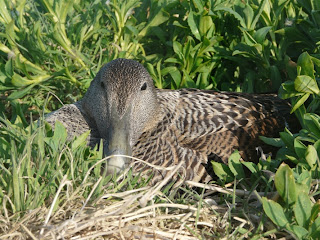Spring showing; Eiders displaying
Nesting pair of Eiders
Sitting still...nesting female Eider
Gas cage Eider -a safe place to nest!
Tuesday 4th September comments: To kick start the series of our breeding seabird review, we’ll start with our most famous nesting duck; the Eider. Since St.Cuthbert first protected them in the 7th century, Eiders have nested on the Farnes and in some years, in good numbers.
This year the first prospecting birds arrived on the islands in late March and the first eggs were discovered on 13th April. Soon after more nesting females arrived on the islands and a total of 443 Eiders nested across the islands this year, 234 less than last year and more worryingly, the lowest Farne Islands breeding total since 1967. This worrying trend is not helped by the fact that just over fifteen years ago, the islands boasted 1,912 nesting birds.
The following figures represent the total number of breeding pairs per island, with the bracketed figures representing the breeding totals for the previous season: Inner Farne 267 (415), West Wideopens 9 (22), East Wideopens 2 (5), Knoxes Reef 2 (6), Staple 23 (28), Brownsman 126 (178), North Wamses 1 (3), South Wamses 4 (6), Big Harcar 2 (5), Northern Hares 0 (2), Longstone 3 (3) and Longstone End 4 (4).
The low breeding total was also compounded by a terrible breeding season as it proved to be one of the worst in over a decade. The ranger staff monitored 288 nests (staff monitored 65% of the population) which produced 455 young (at egg hatching stage the females take the one-day ducklings to sea). This result gives an overall ‘productivity’ of 1.58 (compared to 3.23 last year). This end result is the worst Farnes ‘return’ since the late 1990’s.
Many people will now ask why but as with many seabird questions, we don’t have all the answers. Some females may not have been in good breeding condition to nest this year (females can take a year off!), whilst the high failure rate was as a direct result of heavy rain – females abandoned lots of nests before hatching. Throw in predation, a retracting population heading north and a few more local issues and it’s a sticky web to untangle.
The one thing we can surmise from all this data is that 2012 was not a good year for nesting Eiders on the Farne Islands and we don't want a repeat next year.





No comments:
Post a Comment